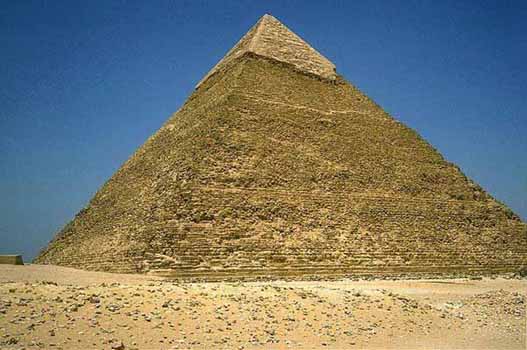
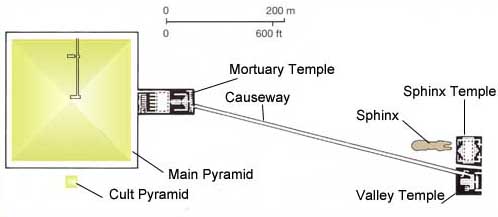
Overall ground plan for the Khafre complex
Original name: Khafre is greatest
Original height: 143.5 m / 478.3 ft
Present day height: 136.4 m / 454.7 ft
Base length: 215.25 m / 717.5 ft - 11 acres
Angle of inclination: 53° 10'
Estimated volume: 1,659,200 m3 / 2,168,900 cu. yd
Date of construction: 4th dynasty, c. 2570 BC
Average Weight of Individual Blocks of Stone:
2.5tons, some of the outer casing blocks of stone weigh in at 7 tons
There is no evidence that anyone was ever buried in the main chamber.
No inscriptions have been found in the pyramid, however there is a sarcophagus in the main chamber. There are two entrances that lead into the pyramid which are placed one directly above the other. The upper entrance is 50 feet (15m) above the ground. This is the one that is used for entrance now. A narrow passage leads into a large limestone chamber. This passageway descends at a 25 degree angle to the chamber. The walls are lined with red granite. This inner chamber is quite large, 46.5' x 16.5' x 22.5' (14.2m x 5m x 6.9m). The roof of the chamber is set at the same angles as the pyramid face.
This is designed to take the weight of the pyramid, as is the relieving chambers in Khufu's pyramid. Apparently the roof designed this way has worked, the pyramid has not collapsed.
The lower corridor is directly under the upper corridor. This lower corridor once contained a portcullis, which could be let down to prevent entry. This corridor declines on the same angle as the upper and eventually joins into the upper. Once joined, the passageway leads into the inner chamber.
Located in the lower passage is a burial chamber that is apparently unfinished and unused. It is in the bedrock under the pyramid. The passageway leads through this chamber and joins the upper corridor.
Khafre's pyramid is hardly smaller than the one of his father, Khufu. As it has a more elevated position and its sides have a steeper angle of inclination, it even appears to be the larger in size. It is the only pyramid that still has parts of its outermost layers of Tura limestone.
The most distinctive feature of Khafre's Pyramid is the topmost layer of smooth stones that are the only remaining casing stones on a Giza Pyramid.
Khafre whose older brother Djedefre died after a few years of governance, dreamed of having the biggest pyramid ever, even bigger than the one of Cheops, his dead father. His plans failed.
After Khufu's pyramid had already been opened and entered in the 7th and the 13th century AD, it was Giovanni Belzoni who wandered around in its passages and chambers in 1818. He entered Khufu's pyramid from one of its two entrances on the northern side and made his way along a descending passageway which had a length of 32 m / 107 ft. Then, he followed a horizontal shaft that lead him directly into the burial chamber where he discovered an austere sarcophagus of pink granite (2.62x1.06m / 8.73x3.53 ft) - it was empty, just like the sarcophagus that was found in the pyramid of Cheops.
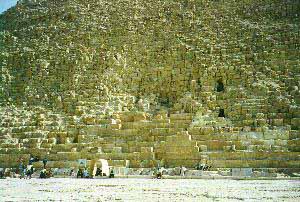
Two entrances - The upper one sealed with a metal door.
The pyramid contains 2 known chambers. One chamber is subterranean, carved into the very bedrock. The other has its floor carved into the bedrock while its upper walls and ceiling pierce into the base of the pyramid.
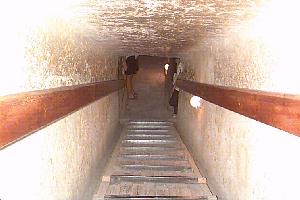
Descending steps
First Chamber - carved in the plateau bedrock is 34' x 10' - no sarcophagus and also includes a pointed ceiling. This chamber may have served for storage of offering material, treasure, or have been the equivalent of a serdab. Perhaps it is this pyramid's equivalent of the middle or so-called Queen's Chamber of the Great Pyramid, which also has a pointed ceiling. However, this room does not contain any niche in the wall for the life-size statue of the king, instead its east wall frames the entrance.
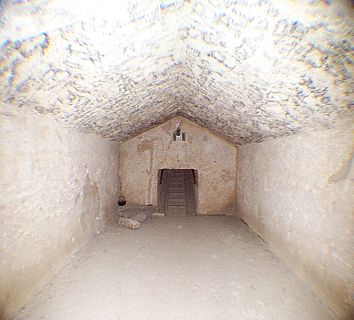
Burial Chamber - 46.5 ft. long and 16.5 ft. wide - pointed ceiling.
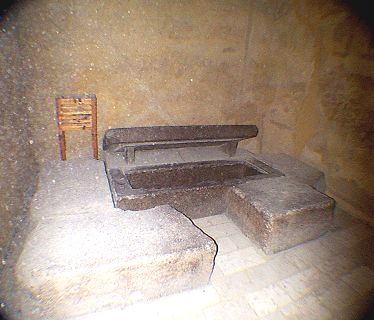
There is a unique black granite sarcophagus in this room in that it was built to be sunken into the floor. The original lid, though no longer attached, lies propped up next to the coffer near the west wall. It is possible that the open niche against the east side of the coffer held the king's canopic chest, the box containing the mummified organs of the king, within ceremonial vases.
A corridor cut from the rock separated the ruined causeway from the Great Sphinx temple and the valley temple. The causeway stretches some forty-six meters connecting these structures with the the mortuary temple just before the main pyramid. It did not run exactly along the east-west axis of the pyramid and mortuary temple, but instead somewhat to the southeast of it due to the fact that the valley temple was erected slightly out of line with the Great Sphinx and the mortuary temple. Archaeologists believe that causeway was probably a covered corridor built of limestone and lined on its exterior by pink granite blocks. Within it may have been decorated with reliefs.
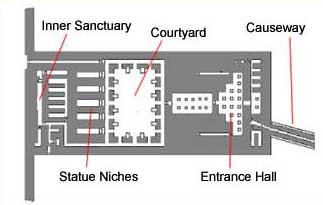
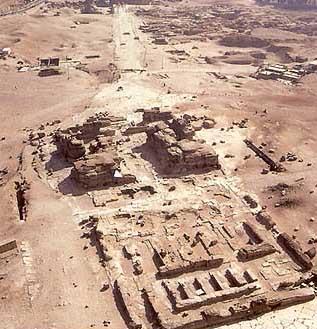
The causeway enters the mortuary temple near the south end of its front facade.
The mortuary temple, unlike later pyramid complexes, did not border directly against the pyramid but was rather separated from its east wall by the pyramid courtyard. Rectangular in its ground plan, it is oriented east-west and has walls built of local limestone that are cased in finer limestone, a technique introduced in this structure. Inside, the building was almost completely lined with granite. The mortuary temple has, in its elemental design, the basics for the mature mortuary temples ultimately perfected by Sahure at Abusir, including an entrance hall, an open courtyard, five statue chapels, various storehouses and an offering hall. This structure marks a real architectural advance, being both larger then previous examples and for the first time, including all five elements that were to become standard.
The entrance to the mortuary temple in the east led through to a small antechamber adorned with a pair of monolithic pink granite pillars. About the entrance area were a few small chambers (two granite chambers immediately to the left of the entrance, and at the other end of a short corridor running along the front of the temple, four more chambers lined with alabaster) that are thought to have been storage annexes or serdabs. Ricke, in his investigation of the mortuary temple, found this area strikingly similar to the valley temple, and considered it a kind of repetition. He designated this area as the "ante-temple" (Vortempel) and the remaining area of the mortuary temple as the "worship temple" (Verehrungstempel).
This antechamber in turn led into the entrance hall itself where there were twelve more similar pairs of pillars to those in the antechamber. This entrance hall had an original ground plan of an inverted T. Hence, the first part of the entrance hall was transverse, with recessed bays. It led in turn to a rectangular section. Off of the transverse part of the hall, two long, narrow chambers branched off from either end, and it has been suggested that huge statues of the king once graced these dim passages.
After the entrance hall there is a large, open courtyard situated in approximately the middle of the temple. Paved in slabs of alabaster and oriented north-south, along its sides runs a covered ambulatory with a flat limestone roof made of slaps supported by broad pillars of pink granite. The lower part of this ambulatory was formed by a dado in red granite and limestone.
It was covered by brilliantly colored reliefs of which only fragments remain. Ricke thought that the ambulatory was fronted by 3.75 meter high statues of Khafre sitting on his throne overlooking the courtyard, but Lehner thinks these were standing statues of the ruler. Lehner bases his belief on the discovery of a small statuette in the workshops west of the pyramid. This artifact shows the ruler, wearing the crown of Upper Egypt, standing in front of a kind of pillar. The remains of a small canal suggest that it was drainage for an altar that stood in the middle of the courtyard.
A door in the west side of the ambulatory communicated with five, long chapels (actually niches) that also originally housed statues of the king. Another narrow corridor opens from the southwest corner of the courtyard and led to an offering hall located in the west part of the temple. The hall was a narrow, long room oriented north-south (in contrast to later mortuary temples) with a false door positioned on the west wall, precisely on the pyramid's long axis. Between the five cult chapels and the offering hall, a group of five storage rooms were provided for cult vessels and offerings used during various ceremonies.
A stairway in the northeast corner of the temple led up to the roof terrace, while in the northwest corner of the courtyard, another corridor led to the paved pyramid enclosure.
Though all of them had been plundered apparently in antiquity, there were five boat bits discovered outside of the mortuary temple. Two of these stood on the north of the temple, while three were to its south. Another pit may have been planned. All of these were carved into the rock in the shape of a boat. Two of the pits still retained their roofing slabs, though all of the pits had been looted, probably during antiquity.
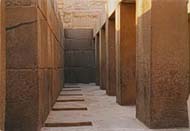
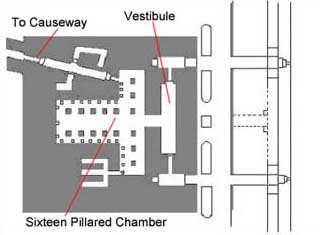
Coming along the causeway, one encounters the valley temple of the pyramid of Chephren which is made from pink granite. What wrongly used to be regarded as the Sphinx temple is still in very good condition. A T-shaped hall held 16 monolithic pylons, each of them 4.15 m / 18.8 ft high. Two Sphinxes each had once guarded the two entrances. The temple was probably used for the process of mummification as remains of a "purification tent" were found in 1995.
The valley temple of Khafre's Giza complex, which is one of the best preserved Old Kingdom temples in Egypt. As a masterful work of ancient Egyptian monumental architecture, it was cleared of sand and in 1869 this temple, along with other monuments at Giza, became the backdrop for the ceremonial opening of the Suez Canal.
The temple was fronted on the east by a large terrace paved with limestone slabs, through which two causeways led from the Nile canal. Just about in the middle of the terrace, fragments of what may have been a small, simple, wood and matting structure was unearthed that may have been the location of a statue depicting Khafre. However, others believe that this was a tent used for purification purposes, though known examples of such a structure are only found in a few private tombs.
In 1995, Zahi Hawass re-cleared the area in front of the Valley temple and in doing so, discovered that the causeways passed over tunnels that were framed with mudbrick walls and paved with limestone. These tunnels have a slightly convex profile resembling that of a boat. They formed a narrow corridor or canal running north-south. In front of the Sphnix Temple, the canal runs into a drain leading northeast, probably to a quay buried below the modern tourist plaza.
The causeways connected the Nile canal with two separate entrances on the Valley temple facade that were sealed by huge, single-leaf doors probably made of cedar wood and hung on copper hinges. Each of these doorways were protected by a recumbent Sphinx. The northern most of these portals was dedicated to the goddess ">Bastet, while the southern portal was dedicated to Hathor.
The temple was laid out in almost a square ground plan. It is situated just next to the Great Sphinx and its associated temple. Not surprisingly, since the valley temple was a gateway or portal to the whole complex, it is very similar to the fore part of Khafre's mortuary temple. Its core wall was built of huge blocks that sometimes weighed as much as one hundred and fifty tons. This inner core was then covered by pink granite slabs, a material used extensively throughout the complex that was quarried near Aswan far to the south. This wall was slightly inclined and rounded at the top, making the whole structure appear somewhat like a mastaba tomb.
Between the two entrances to the valley temple was a vestibule with walls of simple pink granite that were originally polished to a luster. Its floors were paved with white alabaster. A door then led to a T-shaped hall that made up a majority of the temple. This area too was sheathed with polished pink granite and paved with white alabaster, though it was also adorned with sixteen single block pink granite pillars, many of which are still in place today, that supported architrave blocks of the same material, bound together with copper bands in the form of a swallow's tail. These in turn supported the roof.
Here, in the dim light provided by slits at the tops of the walls, stood as many as twenty four statues of the king (though one statue base in the middle that is larger than the others may have been counted twice) made from diorite, slate and alabaster. This line of statues continues along the cross of the T shaped hall ending at a doorway that leads to a corridor from which a stairway ramp winds clockwise up and over the top of the corridor before terminating on the roof of the valley temple.
On the south side of the roof was a small courtyard, situated directly over six storage chambers also built of pink granite and arranged in two stories of three units each. These were embedded in the core masonry of the T shaped hall. Symbolic conduits lined in alabaster, a material specifically identified with purification, run from the temple's roof courtyard down into the deep, dark chambers below. These symbolic circuits run through the entire temple, taking in both the chthonic and the solar aspects of the afterlife beliefs and of the embalming ritual for which the valley temple was the stage, according to some Egyptologists.
Hence, the Polish scholar Bernhardt Grudseloff proposed that purification rituals were carried out on the roof terrace in a tent especially constructed for that purpose. Afterwards, he theorized that the body was embalmed in the temple antechamber.
A French Egyptologist, Etienne Drioton proposed a similar view, only switching the locations to the antechamber for the purification and the embalming on the roof terrace. However, Ricke correctly pointed out that these types of rituals required considerable water that was only available near the canal, so at best the priests of the valley temple could have only performed the rituals symbolically.
At the other end of the cross in the T shaped hall (north), an opening gave way to a passage, also paved with alabaster, that led to the northwest corner of the temple and there joined the causeway.
Kafre's pyramid is surrounded by an inner, huge stone perimeter wall, within which is an open courtyard barely ten meters wide that bounds the four sides of he pyramid proper. This courtyard is paved with limestone slabs of irregular form.
Because of the two different entrances to this structure, some Egyptologists believe that the main Pyramid of Khafre was originally meant to be larger and to stand slightly farther north then its completed position. However, modern scholars with considerable expertise on this pyramid, such as Lehner, doubt this assumption. Like the pyramid of Khufu and others in Egypt, Khafre's structure takes advantage of a rock outcropping to both increase the stability of its core, as well as to conserve the amount of necessary building materials needed for its construction. In fact, the lowest levels of its southwest corner are actually hacked out of the rock subsoil.
The bedrock surface to the northwest had to be cut down some 10 meters by its ancient builders, while the southeast corner had to be built up using mammoth blocks of masonry. However, by far the substance of the pyramid core is made up of locally quarried limestone blocks of approximately equal height. Nearby to the north of they pyramid, one may still clearly see the traces of how these blocks were quarried. The blocks were not laid with the care that was given to the core of Khufu's pyramid, for the layers do not always run exactly horizontally, and the joints are at times very wide. Often, there is no mortar between the blocks. In fact, because the four corner angles were not quite aligned correctly to meet the pyramid apex, there is a very slight twist at the top.
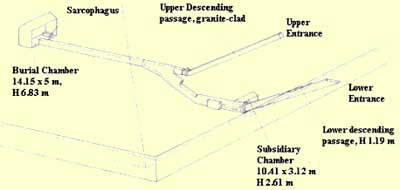
The base levels of the casing were made of pink granite, while the higher layers, which become much smaller towards the top (about one cubit thick) are of fine Turah limestone. The outside faces of the casing blocks are often staggered by a few millimeters rather than flush, which may mean that they were faced prior to their placement. While the pyramidion and the apex have been lost, at the top of the pyramid, a small portion of the original casing remains in place, which helps us see how the finishing blocks were laid and bound to the pyramid core. However, because it is clear that the remaining casing is eroding, recent investigations by Italian experts have shown that the remaining corner edges of the mantle are not completely straight. Individual blocks are slightly turned in various directions. An analysis of this peculiarity suggests that this was the result of seismic activity. Small earthquakes were not uncommon in ancient Egypt, as they are likewise known to occur in modern times.
The oldest of the two entrances into the subterranean depths of Khafre's pyramid is now located in the ground about thirty meters north of the pyramid. Carved completely out of the rock subsoil, it is sometimes called the "lower entrance". This portal communicates with a corridor that at first descends before running horizontally. In this horizontal leg of the corridor, a passage gives way on the west wall to a small chamber cut from the bedrock and provided with a pented roof, where part of the burial equipment was possibly stored. After the horizontal section of the entrance corridor, it finally ascends into a horizontal corridor shared by the "upper entrance".
The second portal, known as the "upper entrance", is located in the north wall of the pyramid's face about twelve meters above ground level. It communicates with a corridor lined in pink granite that first descends before running horizontally at the base of the pyramid. At the transitional point between its descending and horizontal sections, there is a barrier made of pink granite, which in antiquity, grave robbers managed to dig around. The horizontal passage continues south after the barrier, eventually arriving at the burial chamber, which lies on the vertical axis of the pyramid. Given the location and relatively simple construction of the access corridor and the burial chamber, it is likely that the architects of this pyramid sought to avoid the complications that builders of Khufu's pyramid had encountered with their technically difficult system of passageways, barriers and chambers.
As with earlier pyramids, the burial chamber has a rectangular, east-west oriented ground plan which places it at a right angle to the passage system. With the exception of its ceiling, it was excavated completely out of the rock. Located over the pyramid's base, the burial chamber's gabled ceiling is built from enormous pented, limestone blocks. Originally, the intention may have been to cover the burial chamber's walls of this chamber in pink granite. There are shaft entrances in both the north and south walls of the burial chamber that, at first, appear similar to those in the Queen's and King's chambers of the Great Pyramid, but are rather short, horizontal openings that could have been used to reinforce a wooden structure inside the tomb.
Near the west wall of the burial chamber, almost directly under the vertical axis of the pyramid and situated within a niche stands the black granite sarcophagus of the king that originally was surmounted by a sliding lid. The lid was found in two pieces close by. Near the sarcophagus, a small shaft in the floor probably held royal canopic vessel, which would have been the first instance of this funerary equipment placed in a pyramid.. No positively identifiable remains of the king's mummy or his other funerary equipment were found within the pyramid.
The Cult Pyramid
A small, almost completely destroyed cult pyramid (G 2a) sits on the axis of the south side of the main pyramid of Khafre. Cult, or Satellite pyramids as they are sometimes called, are thought to have derived from the south tomb of Djoser's complex at Saqqara, and may have been for the burial of statues dedicated to the ka, or spiritual double, of the king. Originally, it was surrounded by its own enclosure wall. It has a simple substructure that consists of a descending corridor that gives way to an underground chamber with a T-shaped ground plan.
Because this chamber contained bits of wood, carnelian beads, fragments of animal bones and vessel lids, Maragioglio and Rinaldi concluded that it must have served as a tomb for one of Khafre's consorts. However, Stadelmann opposed this view, believing that it was a cult pyramid. His opinion is supported by the cult pyramid attached to Khufu's complex on its southeast corner.
More to the point, Lehner believes that the wood made up a frame of cedar in the form of a sah netjer, or divine booth, which was used to transport a statue to be buried in the subsection of this small pyramid.
Other Structures
In the early 1880s, Petrie also discovered west of Khafre's pyramid beyond the so called outer perimeter wall, the ruins of a structure that contained long, mostly east-west oriented rooms. He assumed, as did some later investigators such as Holscher, that this was a worker's village that lodged as many as four to five thousand men in 111 large rooms. However, later work by Lehner and Hawass seem to suggest that that this facility, rather than a settlement, was instead a storehouse as well as the workshops for the pyramid complex. Interestingly, the great number of mollusk shells that were found here also suggest that the surrounding area was, rather than arid desert as it is today, a kind of savanna with the corresponding flora and fauna.
Violation of the Pyramid
Perhaps as early as the First Intermediate Period, as in the case with other pyramids, thieves had probably already broken into Khafre's tomb. Inscriptions by the "overseer of temple construction" indicate that already by the 19th Dynasty, considerable damage had already occurred. In fact, written sources indicate that, on the orders of Ramesses II, casing from Khafre's pyramid was used for the construction of a temple in Heliopolis. Other sources suggest that a large part of the pyramid casing was removed between 1356 and 1362 for use in the Mosque of al-Hassan.
At any rate, the Arab historian Ibn Abd as-Salaam records that the pyramid was opened up in the 774 after the hegira (1372 C.E.), during the reign of the Great Emir Jalburgh el-Khassaki. It is possible that the tunnels going around the granite barriers in the entry passage could have been dug at that time.
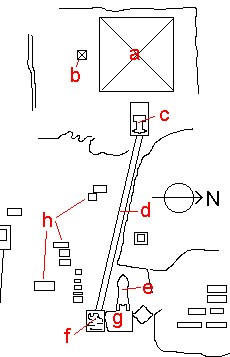
a: Pyramid of Khafre
b: Secondary Pyramid
c: Mortuary Temple
d: Causeway
e: Sphinx
f: Valley Temple
g: Sphinx Temple
h: Mastabas




0 comments:
Post a Comment